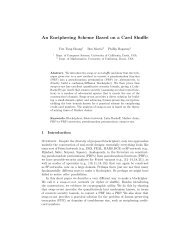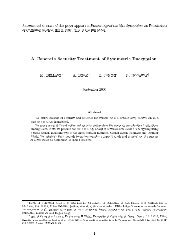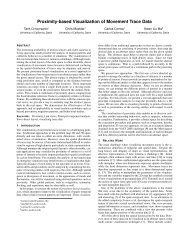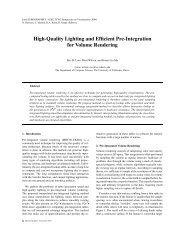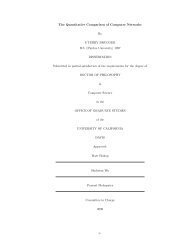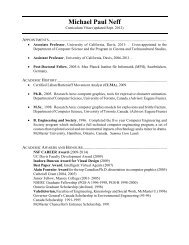Homework Assignment #2
Homework Assignment #2
Homework Assignment #2
Create successful ePaper yourself
Turn your PDF publications into a flip-book with our unique Google optimized e-Paper software.
[01] A = x∈U, p(x) By definition<br />
[02] B = x∈U, q(x) By definition<br />
[03] (A ∩ B) = x∈U, p(x) ∧ q(x) By [01] and [02]<br />
[04] B C = x∈U, ~q(x) By definition<br />
[05] (A ∩ B C) = x∈U, p(x) ∧ ~q(x) By [01] and [04]<br />
[06] (A ∩ B) ∪ (A ∩ B C) = x∈U, (p(x) ∧ q(x)) ∨ (p(x) ∧ ~q(x)) By [03] and [05]<br />
[07] (A ∩ B) ∪ (A ∩ B C) = x∈U, p(x) ∧ (q(x) ∨ ~q(x)) By [06] and DeMorgan’s Law<br />
[08] (A ∩ B) ∪ (A ∩ B C) = x∈U, p(x) ∧ T By [07] and the Complement Law<br />
[09] (A ∩ B) ∪ (A ∩ B C) = x∈U, p(x) By [08] and the Identity Law<br />
[10] (A ∩ B) ∪ (A ∩ B C) = A By [01]<br />
Problem Seven (1.7.20)<br />
Draw the Venn diagrams for each of these combinations of the sets A, B, C.<br />
We assume for each of these, that the intersection of A, B, and C is non-empty. In each picture, the toned area represents<br />
the set in question.<br />
Problem Eight (1.7.22)<br />
a) A ∩ (B ∪ C) b) A C ∩ B C ∩ C C c) (A – B) ∪ (A – C) ∪ (B – C)<br />
Can you conclude that A=B if A, B, and C are sets such that<br />
a) A ∪ C = B ∪ C? No, this would be true if A and B are both subsets of C.<br />
b) A ∩ C = B ∩ C? No, consider the case when C is the empty set.<br />
Problem Nine (1.7.28)<br />
Show that A⊕B = (A – B) ∪ (B – A).<br />
Set-style Proof<br />
There are only two ways and element, x, can be in set A or set B, exclusive. It can be an element of A but not of B (in which<br />
case it is an element of the set A – B) or it can be an element of B but not of A (in which case it is an element of the set B –<br />
A). Therefore, an element, x, is in the set A⊕B only if it is also in the set (A – B) ∪ (B – A), so the two sides are equal.<br />
Proposition-style Proof<br />
Let p(x) be the proposition whose truth set is the set A<br />
Let q(x) be the proposition whose truth set is B<br />
Therefore, (A – B) ∪ (B – A) = x∈U, (p(x) ∧ ~q(x)) ∨ (q(x) ∧ ~p(x))<br />
[01] A = x∈U, p(x) By definition<br />
[02] B = x∈U, q(x) By definition<br />
[03] A⊕B = x∈U, ~(p(x) ∧ q(x)) ∧ (p(x) ∨ q(x)) By [01] and [02]<br />
[04] A⊕B = x∈U, (~p(x) ∨ ~q(x)) ∧ (p(x) ∨ q(x)) By [03] and DeMorgan’s Law<br />
[05] A⊕B = x∈U, [(~p(x) ∨ ~q(x)) ∧ p(x)] ∨ [(~p(x) ∨ ~q(x)) ∧ q(x)) By [04]and the Distributive Law<br />
[06] A⊕B = x∈U, [F ∨ (~q(x) ∧ p(x))] ∨ [(~p(x) ∧ q(x)) ∨ F] By [05] and the Distributive/Complement Law<br />
[07] A⊕B = x∈U, (~q(x) ∧ p(x)) ∨ (~p(x) ∧ q(x)) By [06] and the Complement Law<br />
[08] A⊕B = x∈U, (p(x) ∧ ~q(x)) ∨ (q(x) ∧ ~p(x)) By [07] and the Associative Law<br />
[09] A⊕B = (A – B) ∪ (B – A) By [08] and the definition above



